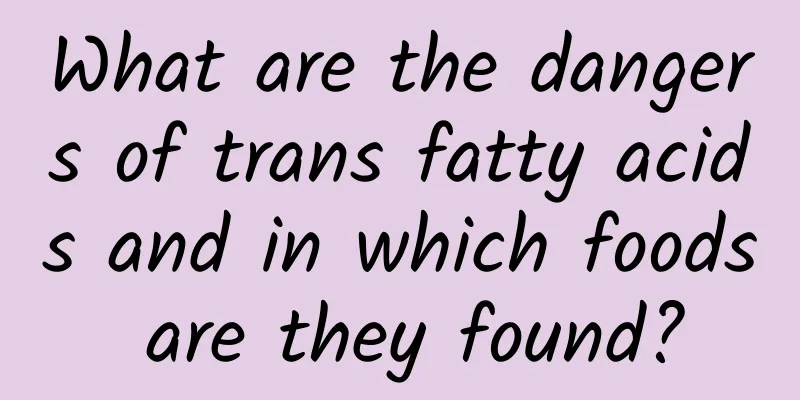What are the dangers of trans fatty acids and in which foods are they found?

|
The report said that among the world's 8 billion people, more than 5 billion people's food contains harmful industrially produced trans fats. Experiments have shown that excessive use of trans fats can easily induce cardiovascular disease and diabetes, thereby increasing people's risk of heart disease and death. The World Health Organization has long been opposed to the use of artificial trans fats. Previously, some countries such as the United States and Europe have formulated policies to completely ban artificial trans fats. So what are the dangers of trans fatty acids? Which foods contain trans fatty acids? Let’s talk about it today. 01. What are the hazards of trans fatty acids? Trans fatty acid (TFA) is a general term for unsaturated fatty acids containing trans non-conjugated double bond structures. This concept is quite professional, but everyone knows that it is a type of fatty acid. However, the impact of trans fatty acids on health cannot be underestimated. Studies have found that trans fatty acids can affect the body's metabolic function. For example, trans fatty acids can affect serum lipid levels, especially cholesterol. Trans fatty acids can significantly increase serum total cholesterol levels and low-density lipoprotein cholesterol levels, while reducing high-density lipoprotein cholesterol levels, resulting in an increase in TC/HDL-C levels. For example, trans fatty acids can cause an increase in serum triglyceride levels. In addition, some other blood biochemicals such as lipoproteins will also change [2,3]. If these changes are not adjusted and corrected in a timely manner, they will have serious consequences for the body in the long run, such as coronary heart disease and diabetes. Studies have found that the intake of trans fatty acids is significantly positively correlated with the incidence of coronary heart disease, and a similar relationship is also found with type 2 diabetes [4]. Because trans fatty acid intake is closely related to health, the world has been working hard to eliminate trans fatty acids in recent years. For example, the "National Food Safety Standard General Rules for Nutrition Labeling of Prepackaged Foods" clearly states that excessive intake of trans fatty acids can increase blood cholesterol, thereby increasing the risk of cardiovascular disease. The daily intake of trans fatty acids should not exceed 2.2g, and excessive intake is harmful to health. Not only that, the World Health Organization has also been paying attention to the issue of trans fatty acids and has proposed an initiative to completely eliminate trans fatty acids produced by the food industry by 2023. Countries around the world are also actively promoting activities to eliminate trans fatty acids. For example, the US FDA requires that trans fatty acids be included in nutrition labels to let users understand the content of this ingredient in food. Similarly, my country also has regulations on trans fatty acids: The "National Food Safety Standard General Rules for Nutrition Labeling of Pre-packaged Foods" requires that when food ingredients contain or hydrogenated and/or partially hydrogenated fats are used in the production process, the content of trans fats (acids) should also be indicated in the nutrition information table. Many other countries have also enacted corresponding regulations to control trans fatty acids.[5] 02. Which foods contain trans fatty acids? In fact, many of the more common milk teas contain trans fatty acids[1]. Below is a sampling of some milk teas on the market, showing the trans fatty acid content of each brand’s milk tea. Even if you say you don't drink milk tea? Many products sold contain trans fatty acids. The oil processing process involves hydrogenation reaction, and partial hydrogenation reaction is also the main factor leading to the appearance of trans fatty acids. This is because hydrogen is added to the unsaturated double bonds of triglycerides under the action of catalysts, causing the double bonds to shift and the cis-trans structure to change, finally producing trans unsaturated fatty acids. If you decide not to eat these outside food and make them yourself, is that okay? The cooking feature of our country is: oil. The refining process of vegetable oil involves a deodorization step, and the high temperature in this step easily causes the dienoic acid esters and trialnoic acid esters in the oil to undergo thermal polymerization and polymerize into trans fatty acids. So this thing is difficult to avoid. Generally speaking, we can only rely on the mandatory requirements of the state on products to reduce trans fatty acids. Of course, if you have the conditions, you can also pay attention to the trans fatty acid content in the product information. Controlling trans fatty acids is a global action. Therefore, we hope that more related technologies can be broken through and promoted in the future, so as to comprehensively reduce the intake of trans fatty acids and protect public health. Of course, being unable to avoid it does not mean completely ignoring it. After all, there is still a difference between more and less, and trans fatty acids are not a good thing after all. Finally, since the health risks of trans fats have been scientifically proven, getting rid of them is an inevitable choice in the long run. Although it is difficult to completely avoid it at present, companies should focus on improving the refining process of vegetable oils and reducing the use of hydrogenated oils; consumers should also correctly understand food nutrition labels, cultivate good eating habits, and choose zero trans fat products as much as possible when they can, so as to reduce trans fat intake. References: 1. Zhou Hongxia, Hua Chun, Ruan Ming, Jia Zhenghua, Shen Juan. Determination of trans fatty acids in milk tea by gas chromatography[J]. Journal of the Chinese Cereals and Oils Association, 2014, 29(09): 102-106. 2. Troisi, Rebecca, WC Willett, and Scott T. Weiss. "Trans-fatty acid intake in relation to serum lipid concentrations in adult men." The American journal of clinical nutrition 56.6 (1992): 1019-1024. 3. Adams, Thaddeus H., et al. "Hamburger high in total, saturated and trans-fatty acids decreases HDL cholesterol and LDL particle diameter, and increases TAG, in mildly hypercholesterolaemic men." British Journal of Nutrition 103.1 (2010): 91-98. 4. Micha, Renata, and Dariush Mozaffarian. "Trans fatty acids: effects on metabolic syndrome, heart disease and diabetes." Nature Reviews Endocrinology 5.6 (2009): 335. 5. Jiang Yuanrong, Xia Shuhua, Zhang Yuquan, Yu Jianguo, Yang Hong. Current status of trans fatty acids in edible oils and fats and production process control[J]. Journal of Chinese Institute of Food Science and Technology, 2010, 10(04): 53-59. |
>>: Preserving the bright moon and clear spring in the Dunhuang desert
Recommend
Inventory | 8 mainstream monetization paths for Internet self-media people!
In the era of self-media, people are no longer si...
Not eating enough staple food can really shorten your life! 5 common eating mistakes, see if you have made any of them?
In order to maintain a good figure and health, ma...
The copywriting is either sexy or frigid.
The worst thing about copywriting is that it is t...
BYD: BYD Brazil sales exceeded 12,000 units in November 2024, ranking among the top ten in the local sales list for the first time
BYD's sales in the Brazilian market have incr...
How can copywriting capture users?
The world is so busy, no one will waste one more ...
APP Promotion Operation Manual Complete Strategy
Starting from the position of mobile Internet mar...
Can domestic 4G chips withstand Qualcomm’s monopoly?
As the National Development and Reform Commission ...
Yuanqi Forest Private Domain Dismantling
This article analyzes the industry background and...
12 tips to achieve rapid growth of user pool!
In this series of courses, we will share with you...
Are mini vegetables more nutritious than regular vegetables?
Rumor: Mini vegetables are newly cultivated veget...
The event is over, but your work has just begun!
In the Internet age, we are surrounded by various...
What are all these colorful tapes used for?
Speaking of tape, I believe everyone is familiar ...
The people who are photographing insects in the fields are actually "programmers"? Explore the magical "insect face recognition"
In our previous article "Pests: How can eati...
How to visit Siheyuan? This guide will give you the answer →
Beijingers affectionately call it Siheyuan It is ...
How to improve the efficiency of App’s invitation mechanism?
The App invitation mechanism is a feature that al...

![[China Association for Science and Technology Agricultural Technology Center "Smart Mom"] Fasting aerobics is more effective, and eating after a meal can help build muscle? Should you eat first or exercise first?](/upload/images/67f1e1f197abd.webp)







